I. What is the Cell Cycle in Mitosis?
Do you remember the song “Circle of Life” in The Lion King? While reviewing and studying this article, really take that song to heart! Taken literally, this is the real “Circle of Life”, just really scaled down to a cellular and biochemical perspective.
It’d make sense for our human cells to have some form of regulation when it comes to their cell growth and proliferation, which is where the cell cycle comes into play! As you’ll see, this highly organized series of steps is crucial for the maintenance of our cellular integrity.
If not for this occurrence, our cells would simply continue to grow and divide rapidly without care which is where we encounter an all too familiar, though devastating, disease of cancer. However, the research still remains optimistic, hoping to use new insights to make an impact in the lives of many.
II. Fundamentals of the Cell Cycle
As mentioned, the cell cycle is a well organized series of cellular processes which contain different phases, all of which are regulated heavily via various checkpoints. Let’s dive in and understand some cell cycle basics!
A. Phases of the Cell Cycle
One great way to depict the cell cycle is as a circle with each phase taking up a portion of the circle, which include: G1, S, G2, and the M phase as well as a quiescent G0 state.
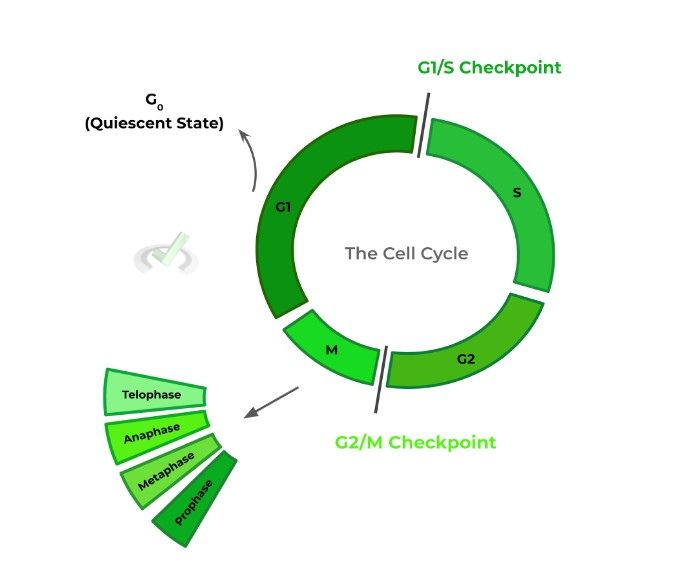
All the phases, except the M phase, comprises what’s called interphase which is where most actively dividing cells spend most of their lifetime.
Note that the steps for mitosis are also listed as a supplement. The mitotic phases have their own article which goes into much more depth. For now, let’s just focus on the other phases!I. G1 Phase
In order to prepare for replication, the cell begins growing in size and in the number of their organelles in order to ensure their even distribution into the daughter cells.
Alluded later in the article, cells in the G1 phase continue to monitor external and internal stimuli to decide whether to continue or halt G1 progression.
II. S (Synthesis) Phase
As implied by the name, the main event of this phase is the synthesis and replication of new DNA in order to evenly distribute the DNA into the 2 daughter cells.
When duplicated, the chromosomes now contain 2 sister chromatids, each genetically identical and held together by the centromere.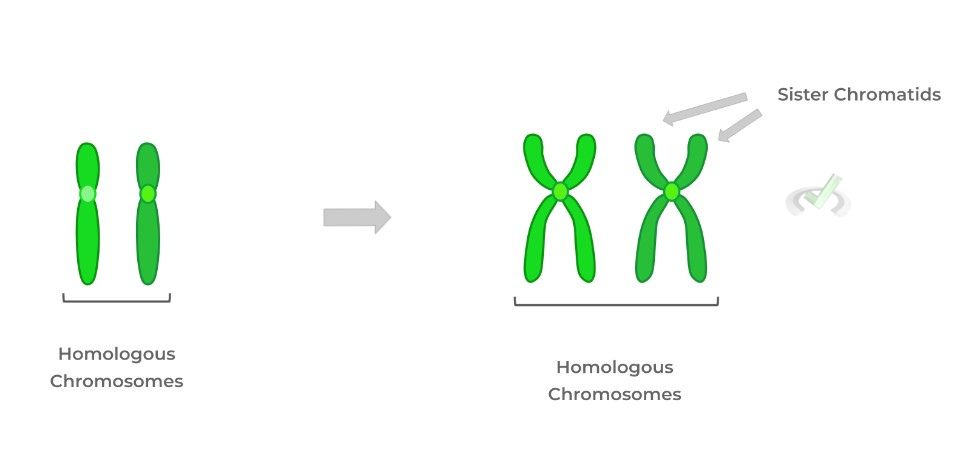
A big way the MCAT tests this concept is to see if you can keep track of the amount of chromatids depending on which phase of the cycle the cell is in!
III. G2 Phase
Similar to its G1 counterpart, the G2 phase still sees the cell continue to grow to prepare for mitotic division by also beginning to synthesize various mitotic proteins.
Additionally, the cell ensures that no damage or mutations have occurred during the DNA replication during the S phase.
If mutations and errors are found, entrance into the M phase is halted until the errors are fixed via various exonucleases and endonucleases.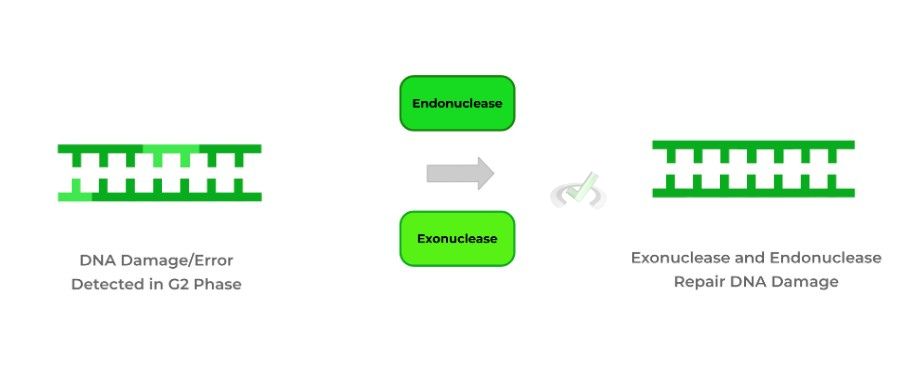
IV. M (Mitotic) Phase
While this has its own, in depth article, we’ll just introduce the main mitotic phases which include: prophase, metaphase, anaphase, and telophase, eventually followed by cytokinesis to generate 2 genetically identical daughter cells.
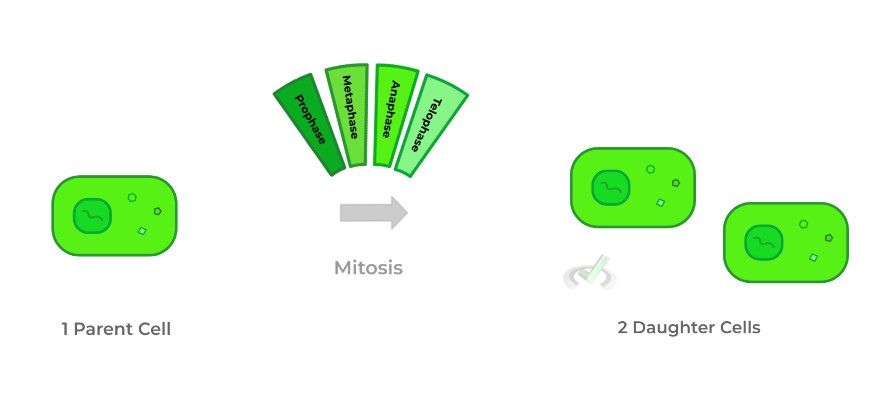
Afterwards, the cycle restarts with the cells entering again into G1 or G0 phase (upcoming) depending on what’s needed for the cell.
V. G0 Phase: Growth Arrest
As alluded to previously, the G0 phase is a specialized, quiescent phase that a cell can enter when not actively pursuing to divide.
Neurons are examples of cells who spend most of their lifetime in the G0 phase as they don’t require much extended proliferation after maturation.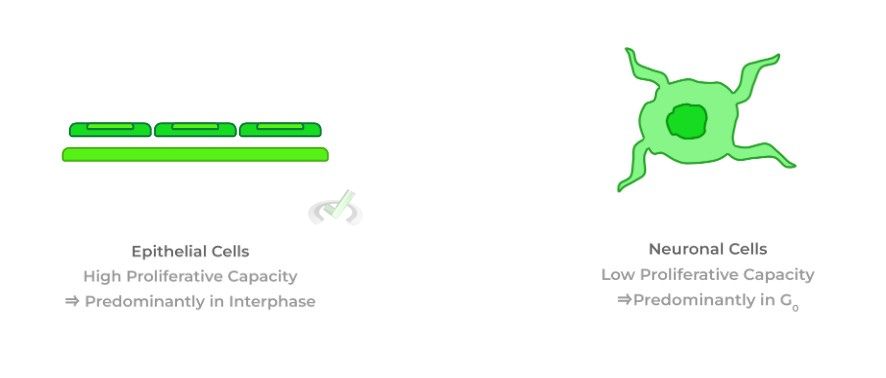
Compare this to epithelial cells such as those in the GI tract and epidermis, which have a high proliferative capacity as they tend to die and deteriorate much quicker.
B. Checkpoint Control of Cell Cycle
As seen in the first figure of the article, there are some checkpoints along the cell cycle that are points of regulation to ensure that cell cycle progression is correct and warranted.
I. G1/S Checkpoint
A great phrase to describe this checkpoint is a “point of no return”, as after the cell passes this checkpoint, it’s committed to dividing.
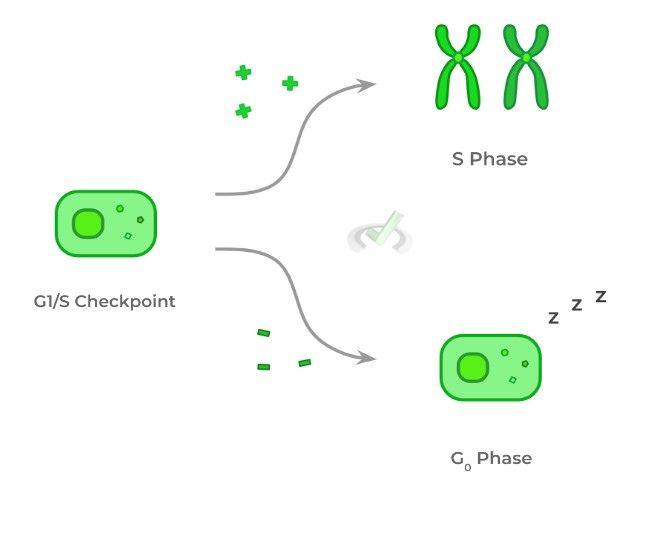
As shown above, the cell accumulates all the positive and negative growth signals which determines whether the checkpoint is passed or not.
A dominance of positive growth signals results in passage of the checkpoint while a dominance of negative signals results in the cell entering into the G0 phase.II. G2/M Checkpoint
The main regulator of this checkpoint is checking for any DNA damage before proceeding to mitosis.
If DNA damage/errors are present, various exonucleases and endonucleases enact DNA repair. If none are present, the cell goes into mitosis.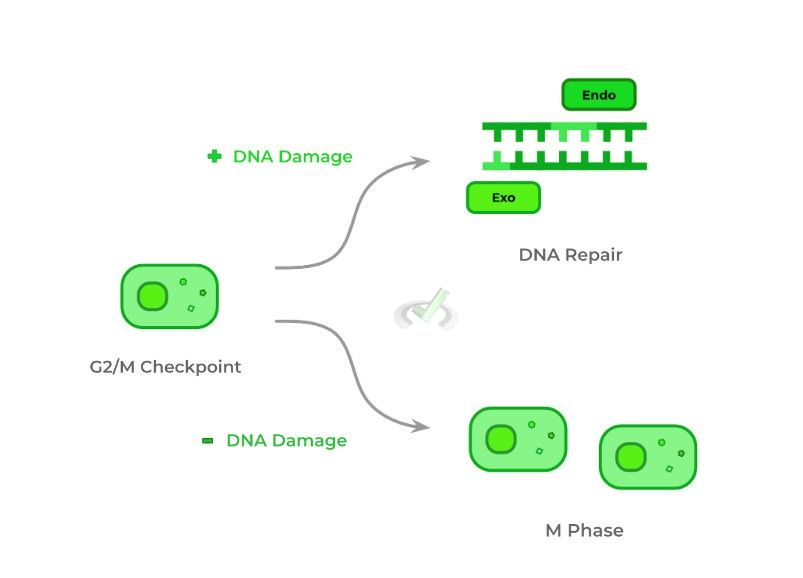
C. Cancer Cells: Loss of Cell Cycle Control
When these checkpoints aren’t tightly controlled, these lead to the uncontrolled progression of the cell cycle which unfortunately can lead to cancer. Let’s discuss 2 important gene types: oncogenes and tumor suppressor genes.
I. Biosignaling: Oncogenes
Let’s first define their precursors in order to understand oncogenes: proto-oncogenes are genes which code for proteins that promote normal cell cycle progression and growth.
When these genes are mutated in a way where they’re constantly active, they are converted to oncogenes, eventually promoting constant, unregulated cell cycle progression and growth.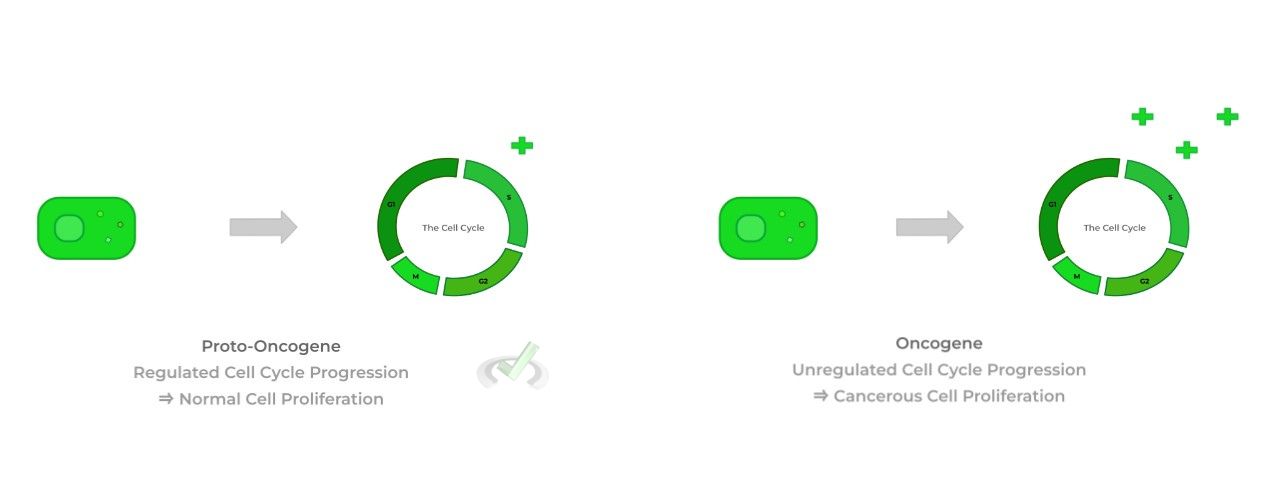
II. Biosignaling: Tumor Suppressor Genes
As their name implies, tumor suppressor genes work to prevent the formation of cancerous tumors by inhibiting cell cycle progression and growth when not warranted.
When these genes are mutated in a way where they become nonfunctional, they experience a loss of function mutation!
Because they now cannot inhibit cell cycle progression, the cell is free to undergo the cell cycle and undergo unregulated cell proliferation.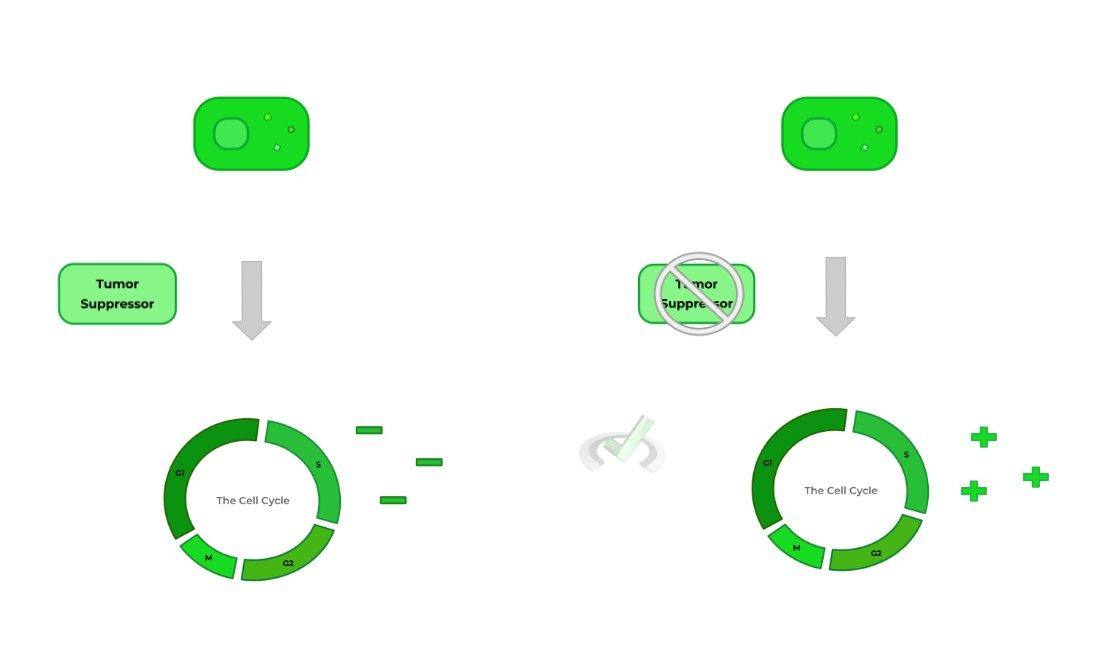
III. Bridge/Overlap
To give the above topic a little more context, it’s best to give a well-known example. The p53 protein is often referred to as the master regulator, as it signals many downstream effects to ensure regulation of the cell cycle.
I. p53: The Master Regulator
The p53 protein is a well known tumor suppressor protein and is in fact the most mutated tumor suppressor protein in cancers. After seeing all its downstream effects, you can see why!
All the downstream effects, including apoptosis, cell senescence (cell division termination), DNA repair, all are events that cancer cells want to prevent in order to promote their growth.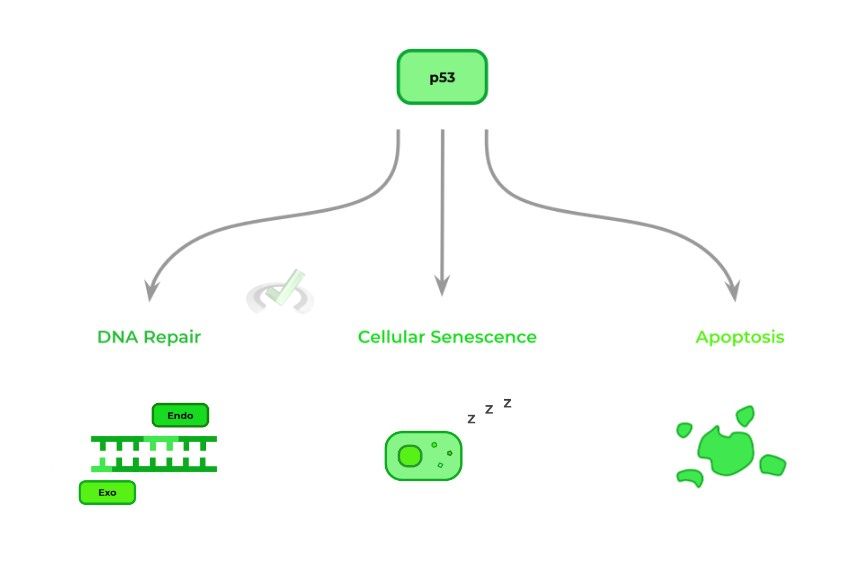
By having a loss of function of mutation in p53, cancer cells can eliminate all these downstream effects, resulting in increased cell cycle and cancer progression.
IV. Bridge/Overlap
Let’s take this time to wrap up & concisely summarize what we covered above in the article!
A. Phases of the Cell Cycle
The cell cycle is divided into the G1, S, G2, and M phase with an additional quiescent G0 state while also being regulated by many checkpoints.
I. G1 Phase
This phase consists of the cell growing in both size and number of organelles in order to allow for an even distribution of each into the 2 daughter cells.
II. S (Synthesis) Phase
As implied by the name, this stage involves the synthesis and replication of DNA to also allow for their even distribution.
The replicated DNA contains 2 sister chromatids, each genetically identical and held together by the centromere.
III. G2 Phase
Similar to the G1 phase, the cell still continues to grow and begins to synthesize various mitotic proteins in order to add in the following phase.
In addition, if DNA damage or error is detected such as mutations, entrance to the M phase is halted while endonucleases and exonucleases work to repair the damage.IV. M (Mitotic Phase)
Mitosis ultimately results in the generation of 2 genetically identical daughter cells from 1 parent cell and consists of 4 main phases: prophase, metaphase, anaphase, and telophase.
V. G0 Phase: Growth Arrest
Sometimes, cells enter the G0 phase when not actively pursuing to divide. One great example of these cells include neuronal cells.
B. Checkpoint Control of the Cell Cycle
Furthermore, various checkpoints and regulations along the cell cycle pathway ensures that progression through the cell cycle is functioning properly and is warranted.
I. G1/S Checkpoint
In this checkpoint, the cell accumulates all the positive and negative growth stimuli in order to decide if further progression should occur or whether the cell enters back into the G0 state.
The checkpoint has often been termed the “point of no return” because the cell commits to division after passing this checkpoint.II. G2/M Checkpoint
This checkpoint checks for any DNA damage that may have occurred during the S phase, which it will repair if found. If no damage is found, the cell then finally enters into the M phase.
C. Cancer Cells: Loss of Cell Cycle Control
When these checkpoints aren’t regulated, this can lead to rapid cell cycle progression and eventually unregulated cell proliferation which can unfortunately lead to cancer.
I. Biosignaling: Oncogenes
When proto-oncogenes, genes which are involved in promoting normal cell cycle progression and growth, are mutated to where they’re constantly active, oncogenes are formed.
This represents a gain of function mutation because an addition to oncogenic activity leads to the promotion of cancer progression.II. Biosignaling: Tumor Suppressor Genes
As implied by their name, these genes cause the formation of tumor forming cancer cells by inhibiting unwarranted cell cycle progression.
When these genes are mutated to where their function becomes defective, it represents a loss of function mutation because this loss of function also furthers cancer progression.
V. Practice
Take a look at these practice questions to see and solidify your understanding!
Sample Practice Question 1:
In what phase of the cell cycle would you expect the enzyme DNA polymerase to be most active in?
A. G1
B. S
C. G2
D. M
Ans. B
Recall that the S phase of the cell cycle is where the synthesis and replication of new DNA takes place! As such, the enzyme for DNA replication, DNA polymerase, would have high activity in this stage!
Sample Practice Question 2:
Apoptosis is defined as programmed cell death. In the context of cancer, what type of mutation would cancer want to give to a pro-apoptotic protein and anti-apoptotic protein, respectively?
A. Gain of Function; Gain of Function
B. Gain of Function; Loss of Function
C. Loss of Function; Loss of Function
D. Loss of Function, Gain of Function
Ans. D
Cancer cells would want to minimize and eliminate the process of apoptosis as this would be detrimental to cancer cell progression. As such, it would want to inhibit the function of the pro-apoptotic protein (loss of function) and promote the function of the anti-apoptotic protein.



 To help you achieve your goal MCAT score, we take turns hosting these
To help you achieve your goal MCAT score, we take turns hosting these 
























